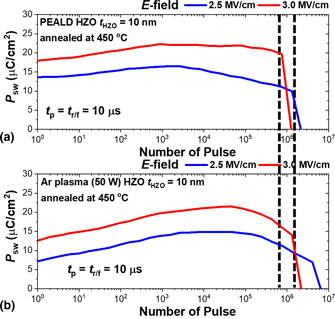Article contents
Exploring argon plasma effect on ferroelectric Hf0.5Zr0.5O2 thin film atomic layer deposition
Published online by Cambridge University Press: 05 October 2020
Abstract

The doped/alloyed HfO2 and ZrO2 thin films revolutionized not only the field of ferroelectric physics but also various ranges of device applications. Especially when the two oxides are combined in an 1:1 ratio, the ferroelectric polarization of the material became the most distinctive. Many researchers have investigated various different process conditions such as controlling Hf0.5Zr0.5O2 (HZO) film thickness and modifying different metal electrodes. Here, we explored the effect of additional Ar plasma treatment to the HZO film. The additional Ar plasma was exposed to the plasma-enhanced atomic layer deposition (PEALD) HZO for this study. Then, the sample was compared with a conventional PEALD and thermal ALD HZO films. By understanding the polarization–electric field (P–E), current–electric field (I–E), and electrical breakdown characteristics of the different samples, it was found that the Ar plasma treatment can control the degree of ferroelectric and antiferroelectric phases of HZO film.
- Type
- Article
- Information
- Copyright
- Copyright © The Author(s), 2020, published on behalf of Materials Research Society by Cambridge University Press
References
- 7
- Cited by



